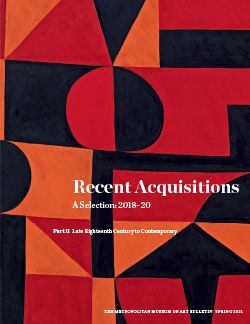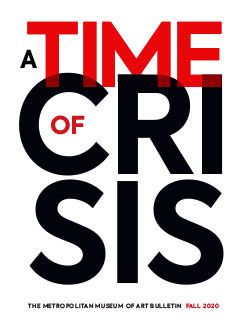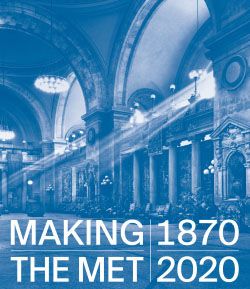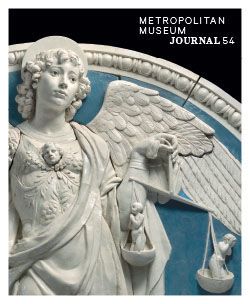MetPublications
Showing 1 – 10 results of 122
Sort By:
 Every two years the fall issue of The Met's quarterly Bulletin celebrates notable recent acquisitions and gifts to the collection. Highlights of Recent Acquisitions 2020–2022 include the Mantuan Roundel by Gian Marco Cavalli, a recently rediscovered tour de force from the early Renaissance; the archive of photographer James Van Der Zee, one of the most celebrated chroniclers of Black life in New York City during the Harlem Renaissance; a pair of sculptures by the renowned contemporary American artist Robert Gober; Thomas Sully’s magisterial portrait of Queen Victoria; and Poussin’s Agony in the Garden, one of only two accepted works by the artist in oil on copper. This publication also honors the many generous contributions from donors that make possible the continued growth of The Met collection.Download PDFFree to download
Every two years the fall issue of The Met's quarterly Bulletin celebrates notable recent acquisitions and gifts to the collection. Highlights of Recent Acquisitions 2020–2022 include the Mantuan Roundel by Gian Marco Cavalli, a recently rediscovered tour de force from the early Renaissance; the archive of photographer James Van Der Zee, one of the most celebrated chroniclers of Black life in New York City during the Harlem Renaissance; a pair of sculptures by the renowned contemporary American artist Robert Gober; Thomas Sully’s magisterial portrait of Queen Victoria; and Poussin’s Agony in the Garden, one of only two accepted works by the artist in oil on copper. This publication also honors the many generous contributions from donors that make possible the continued growth of The Met collection.Download PDFFree to download The second volume in a special two-part edition of Recent Acquisitions, this Bulletin celebrates works acquired by the Museum in 2019 and 2020, many of which were gifts bestowed in honor of the Museum’s 150th anniversary year. Highlights of this volume include Jean-Baptise Carpeaux’s astonishing portrayal of an African woman in the marble sculpture Why Born Enslaved!, a monumental storage jar by African American potter and poet David Drake, an exquisite lacquer mirror case depicting an 1838 meeting between the crown prince of Iran and the tsar of Russia, and Carmen Herrera’s abstract work dating to 1949, Iberic. This publication also honors the many generous contributions from donors that make possible the continued growth of The Met's collection.Download PDFFree to download
The second volume in a special two-part edition of Recent Acquisitions, this Bulletin celebrates works acquired by the Museum in 2019 and 2020, many of which were gifts bestowed in honor of the Museum’s 150th anniversary year. Highlights of this volume include Jean-Baptise Carpeaux’s astonishing portrayal of an African woman in the marble sculpture Why Born Enslaved!, a monumental storage jar by African American potter and poet David Drake, an exquisite lacquer mirror case depicting an 1838 meeting between the crown prince of Iran and the tsar of Russia, and Carmen Herrera’s abstract work dating to 1949, Iberic. This publication also honors the many generous contributions from donors that make possible the continued growth of The Met's collection.Download PDFFree to download The first of a special two-part edition of Recent Acquisitions, this Bulletin celebrates works acquired by the Museum in 2019 and 2020, many of which were gifts bestowed in honor of the Museum’s 150th anniversary year. Highlights of this volume include a sumptuous set of handscrolls depicting The Tale of Genji, a second-century Roman wellhead, a drawing of a landscape by French artist Claude Lorrain, and nearly one hundred Indian paintings. This publication also honors the many generous contributions from donors that make possible the continued growth of The Met's collection.Download PDFFree to download
The first of a special two-part edition of Recent Acquisitions, this Bulletin celebrates works acquired by the Museum in 2019 and 2020, many of which were gifts bestowed in honor of the Museum’s 150th anniversary year. Highlights of this volume include a sumptuous set of handscrolls depicting The Tale of Genji, a second-century Roman wellhead, a drawing of a landscape by French artist Claude Lorrain, and nearly one hundred Indian paintings. This publication also honors the many generous contributions from donors that make possible the continued growth of The Met's collection.Download PDFFree to download In honor of the institution’s 150th year, this publication celebrates the 203 collectors who committed more than 2,500 works of art to The Met for the sesquicentennial. These meaningful additions change the ways in which we think about the Museum’s holdings and deepen the stories The Met can tell about all the works in the collection. Highlights featured in this volume include an imposing stone head from an Egyptian sarcophagus; an opulent horse armor commissioned by King Philip IV of Spain; a Tibetan war mask; an early American daguerreotype; Sir Edward Burne-Jones’s enigmatic watercolor; an early twentieth-century Japanese bamboo shrine cabinet; poignant photographs made by Robert Frank for his iconic series The Americans; the Cuban American artist Carmen Herrera’s 1949 tondo Iberic; Steve Miller’s 1961 Gibson guitar; important works by Georg Baselitz; art from the Iranian Saqqakhana school; the vibrant bark painting of Aboriginal Australian artist Nonggirrnga Marawili; and recent creations by artists such as Cecily Brown, Peter Doig, Robert Gober, and Wangechi Mutu.
In honor of the institution’s 150th year, this publication celebrates the 203 collectors who committed more than 2,500 works of art to The Met for the sesquicentennial. These meaningful additions change the ways in which we think about the Museum’s holdings and deepen the stories The Met can tell about all the works in the collection. Highlights featured in this volume include an imposing stone head from an Egyptian sarcophagus; an opulent horse armor commissioned by King Philip IV of Spain; a Tibetan war mask; an early American daguerreotype; Sir Edward Burne-Jones’s enigmatic watercolor; an early twentieth-century Japanese bamboo shrine cabinet; poignant photographs made by Robert Frank for his iconic series The Americans; the Cuban American artist Carmen Herrera’s 1949 tondo Iberic; Steve Miller’s 1961 Gibson guitar; important works by Georg Baselitz; art from the Iranian Saqqakhana school; the vibrant bark painting of Aboriginal Australian artist Nonggirrnga Marawili; and recent creations by artists such as Cecily Brown, Peter Doig, Robert Gober, and Wangechi Mutu.
A Time of Crisis
2020This special issue of the Bulletin reflects on some of the crises gripping our world in the present moment, including the catastrophic impact of the COVID-19 pandemic and the continuing tragedy of racial injustice. Voices from The Metropolitan Museum of Art present their personal perspectives on issues and challenges facing us all while connecting these difficult times to art, artists, and the Museum’s history. Conceived and written during the Museum’s unprecedented closure, this compelling publication reflects on art’s power to inspire, comfort, and heal.Download PDFFree to download The Metropolitan Museum of Art’s renowned collection spans the globe and represents over five thousand years of human creativity. This innovative book celebrates the Museum’s 150th anniversary and highlights its the most popular works while offering fresh ways of exploring visual culture from prehistory to the present. Art = also celebrates the 20th anniversary of The Met’s award-winning online feature, the Heilbrunn Timeline of Art History. The book draws on the diversity of interests expressed by the Museum’s online visitors by featuring wide-ranging texts and images from the most viewed webpages of this popular digital project. Unlike traditional surveys of art history, this volume groups works of art by thematic keywords, providing a new perspective on these well-known paintings, sculptures, photographs, decorative arts, and much more. The nearly 900 works of art in Art = appear across three color-coded chapters: Material/Technique, Period/Place/Style, and Object/Subject. In the first section, works of art are grouped by medium or method such as Drawing, Marble, Watercolor, and Wood. The second section organizes work by time period, movement, or geography, allowing readers to focus on topics such as Ancient Egyptian Art, Impressionism, and Japanese Art. The third section arranges work by motifs, such as Flowers, Food, and Motherhood and by object type, like Furniture, Jewelry, and Self-Portrait. Art = also features more than 160 informative essays written by the Museum’s experts that offer additional cultural and historical context. Color-coded symbols link each essay and work of art to other essays and keywords. The publication’s dynamic structure provides an experience that is different on each reading, inspiring new connections and raising the question: What does art equal today?
The Metropolitan Museum of Art’s renowned collection spans the globe and represents over five thousand years of human creativity. This innovative book celebrates the Museum’s 150th anniversary and highlights its the most popular works while offering fresh ways of exploring visual culture from prehistory to the present. Art = also celebrates the 20th anniversary of The Met’s award-winning online feature, the Heilbrunn Timeline of Art History. The book draws on the diversity of interests expressed by the Museum’s online visitors by featuring wide-ranging texts and images from the most viewed webpages of this popular digital project. Unlike traditional surveys of art history, this volume groups works of art by thematic keywords, providing a new perspective on these well-known paintings, sculptures, photographs, decorative arts, and much more. The nearly 900 works of art in Art = appear across three color-coded chapters: Material/Technique, Period/Place/Style, and Object/Subject. In the first section, works of art are grouped by medium or method such as Drawing, Marble, Watercolor, and Wood. The second section organizes work by time period, movement, or geography, allowing readers to focus on topics such as Ancient Egyptian Art, Impressionism, and Japanese Art. The third section arranges work by motifs, such as Flowers, Food, and Motherhood and by object type, like Furniture, Jewelry, and Self-Portrait. Art = also features more than 160 informative essays written by the Museum’s experts that offer additional cultural and historical context. Color-coded symbols link each essay and work of art to other essays and keywords. The publication’s dynamic structure provides an experience that is different on each reading, inspiring new connections and raising the question: What does art equal today? Published to celebrate The Metropolitan Museum of Art’s 150th anniversary, Making The Met, 1870–2020 examines the institution’s evolution from an idea—that art can inspire anyone who has access to it—to one of the most beloved global collections in the world. Focusing on key transformational moments, this richly illustrated book provides insight into the visionary figures and events that led The Met in new directions. Among the many topics explored are the impact of momentous acquisitions, the central importance of education and accessibility, the collaboration that resulted from international excavations, the Museum’s role in preserving cultural heritage, and its interaction with contemporary art and artists. Complementing this fascinating history are more than two hundred works that changed the very way we look at art, as well as rarely seen archival and behind-the-scenes images. In the final chapter, Met Director Max Hollein offers a meditation on evolving approaches to collecting art from around the world, strategies for reaching new and diverse audiences, and the role of museums today.
Published to celebrate The Metropolitan Museum of Art’s 150th anniversary, Making The Met, 1870–2020 examines the institution’s evolution from an idea—that art can inspire anyone who has access to it—to one of the most beloved global collections in the world. Focusing on key transformational moments, this richly illustrated book provides insight into the visionary figures and events that led The Met in new directions. Among the many topics explored are the impact of momentous acquisitions, the central importance of education and accessibility, the collaboration that resulted from international excavations, the Museum’s role in preserving cultural heritage, and its interaction with contemporary art and artists. Complementing this fascinating history are more than two hundred works that changed the very way we look at art, as well as rarely seen archival and behind-the-scenes images. In the final chapter, Met Director Max Hollein offers a meditation on evolving approaches to collecting art from around the world, strategies for reaching new and diverse audiences, and the role of museums today. The Metropolitan Museum Journal is issued annually and publishes original research on works of art in the Museum’s collection. Highlights of volume 54 include conservators’ discoveries of Renaissance sculptor Andrea della Robbia’s workshop techniques; a new reading of lavishly dressed women on tile panels from 17th-century Iran; and John Singer Sargent’s decisive role in choosing his socialite sitters’ fashionable attire.Download PDFFree to download
The Metropolitan Museum Journal is issued annually and publishes original research on works of art in the Museum’s collection. Highlights of volume 54 include conservators’ discoveries of Renaissance sculptor Andrea della Robbia’s workshop techniques; a new reading of lavishly dressed women on tile panels from 17th-century Iran; and John Singer Sargent’s decisive role in choosing his socialite sitters’ fashionable attire.Download PDFFree to download Emperor Maximilian I (1459–1519) held sway over much of Europe in the late fifteenth and early sixteenth centuries. He boldly established the prominence of the Habsburgs, enhancing their prestige and expanding their dominions to the Low Countries, Hungary, Bohemia, parts of Italy, and Spain. As he skillfully crafted a public persona and personal mythology, Maximilian indulged his passion for the trappings and ideals of knighthood, including beautifully decorated suits of armor, which eventually earned him the sobriquet “the Last Knight.” This delightful album, published on the five hundredth anniversary of Maximilian’s death, features an engaging text about his life and legacy, gorgeously illustrated with armor, paintings, prints, and an exquisite tapestry.Download PDFFree to download
Emperor Maximilian I (1459–1519) held sway over much of Europe in the late fifteenth and early sixteenth centuries. He boldly established the prominence of the Habsburgs, enhancing their prestige and expanding their dominions to the Low Countries, Hungary, Bohemia, parts of Italy, and Spain. As he skillfully crafted a public persona and personal mythology, Maximilian indulged his passion for the trappings and ideals of knighthood, including beautifully decorated suits of armor, which eventually earned him the sobriquet “the Last Knight.” This delightful album, published on the five hundredth anniversary of Maximilian’s death, features an engaging text about his life and legacy, gorgeously illustrated with armor, paintings, prints, and an exquisite tapestry.Download PDFFree to download Maximilian I (1459–1519) skillfully crafted a public persona and personal mythology that eventually earned him the romantic sobriquet “Last Knight.” From the time he became duke of Burgundy at the age of eighteen until his death, his passion for the trappings and ideals of knighthood served his worldly ambitions, imaginative strategies, and resolute efforts to forge a legacy. A master of self-promotion, he ordered exceptional armor from the most celebrated armorers in Europe, as well as heroic autobiographical epics and lavish designs for prints. Indeed, Maximilian’s quest to secure his memory and expand his sphere of influence, despite chronic shortages of funds that left many of his most ambitious projects unfinished, was indomitable. Coinciding with the 500th anniversary of Maximilian’s death, this catalogue is the first to examine the masterworks that he commissioned, revealing how art and armor contributed to the construction of Maximilian’s identity and aspirations, and to the politics of Europe at the dawn of the Renaissance.
Maximilian I (1459–1519) skillfully crafted a public persona and personal mythology that eventually earned him the romantic sobriquet “Last Knight.” From the time he became duke of Burgundy at the age of eighteen until his death, his passion for the trappings and ideals of knighthood served his worldly ambitions, imaginative strategies, and resolute efforts to forge a legacy. A master of self-promotion, he ordered exceptional armor from the most celebrated armorers in Europe, as well as heroic autobiographical epics and lavish designs for prints. Indeed, Maximilian’s quest to secure his memory and expand his sphere of influence, despite chronic shortages of funds that left many of his most ambitious projects unfinished, was indomitable. Coinciding with the 500th anniversary of Maximilian’s death, this catalogue is the first to examine the masterworks that he commissioned, revealing how art and armor contributed to the construction of Maximilian’s identity and aspirations, and to the politics of Europe at the dawn of the Renaissance.